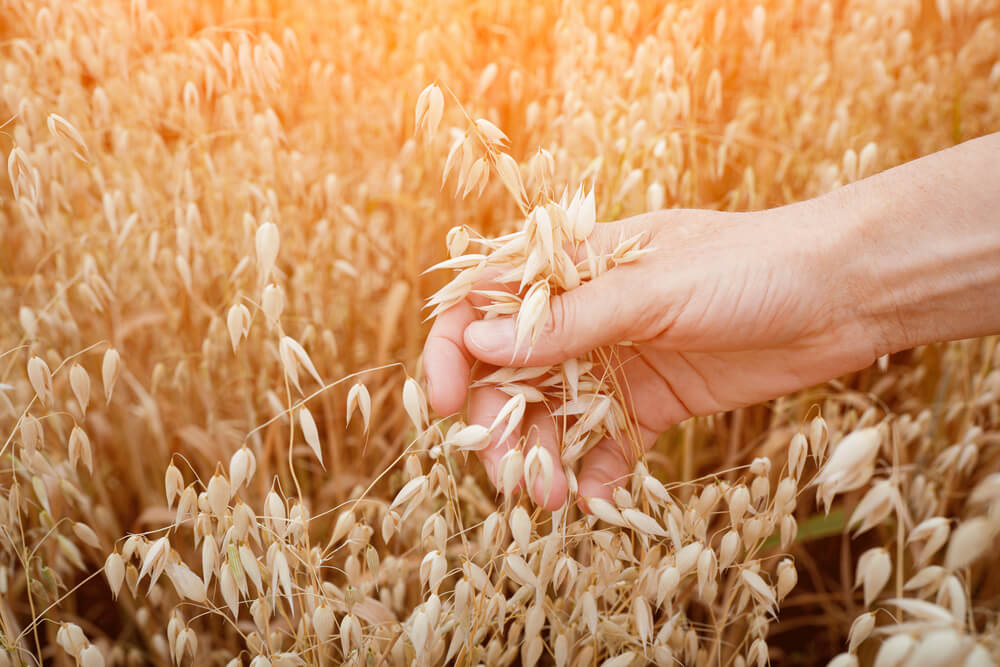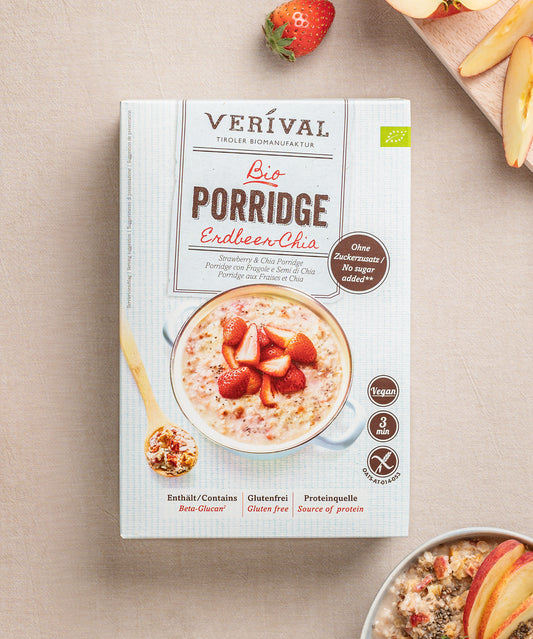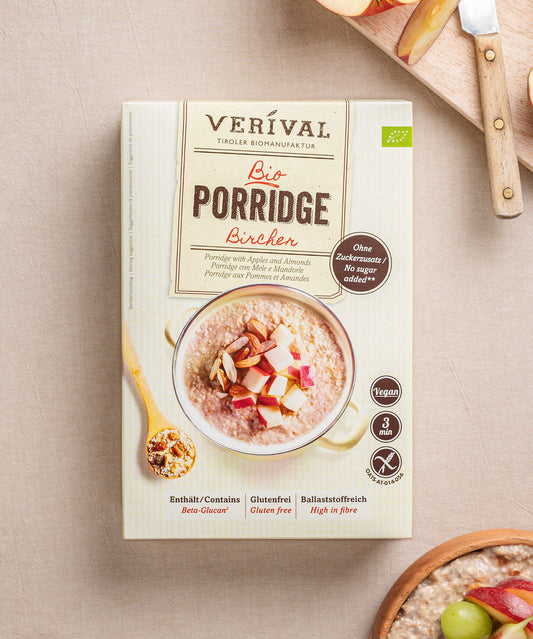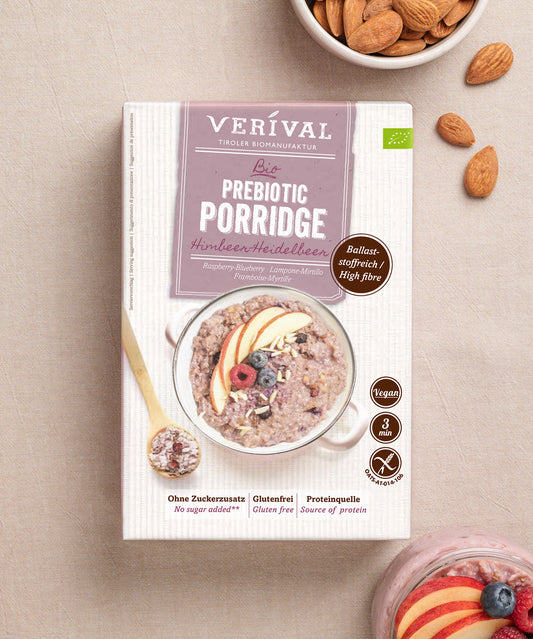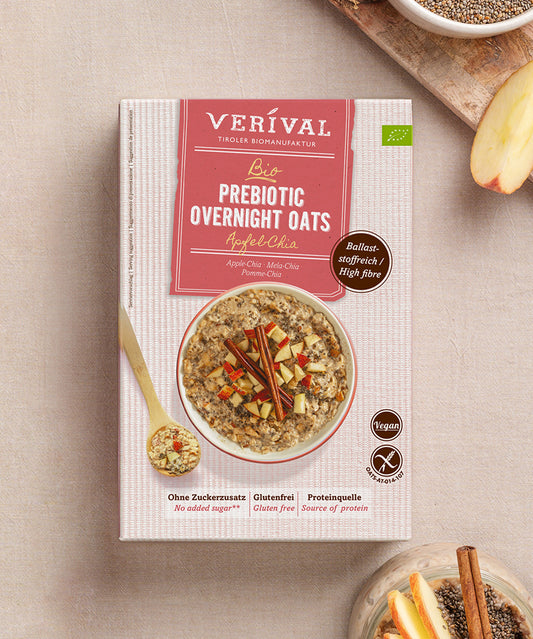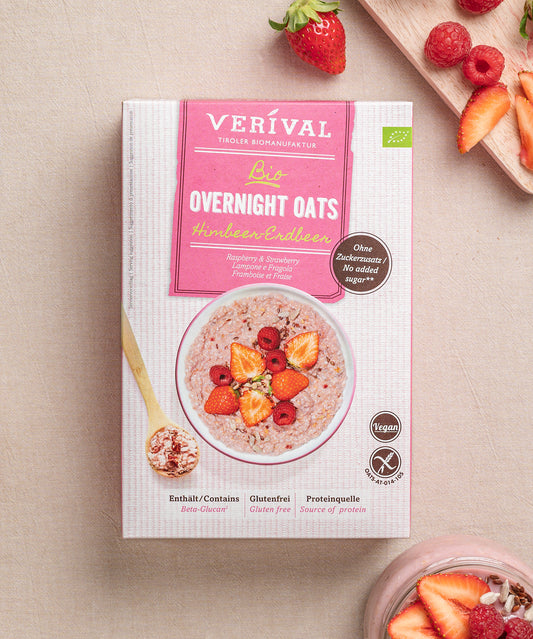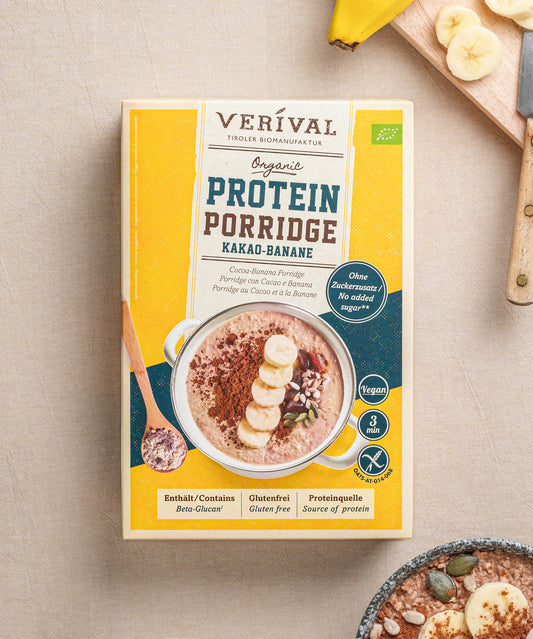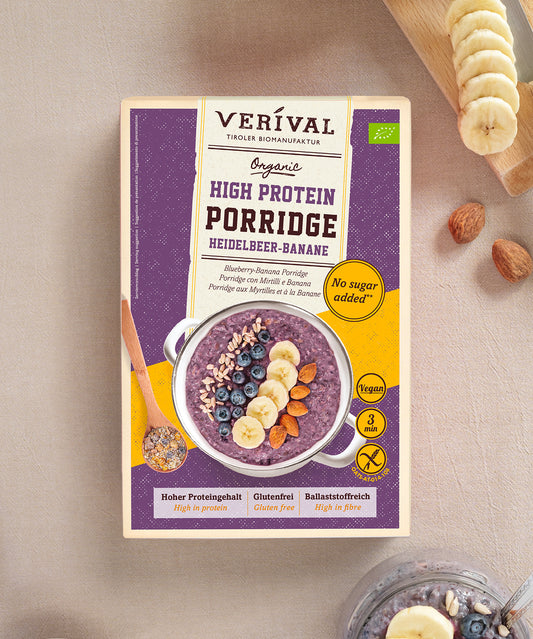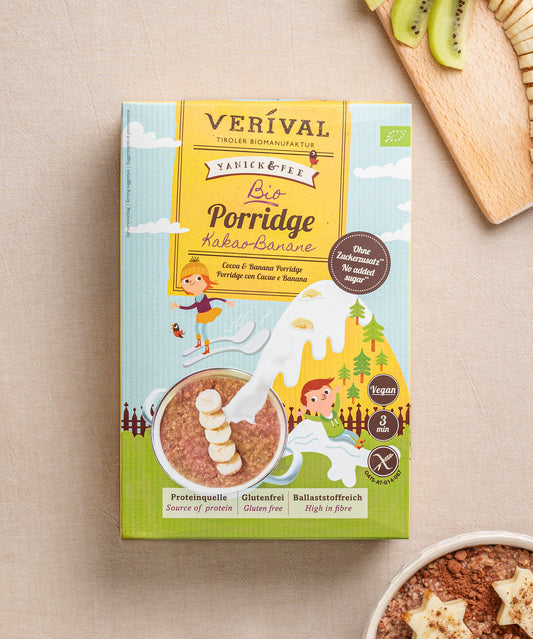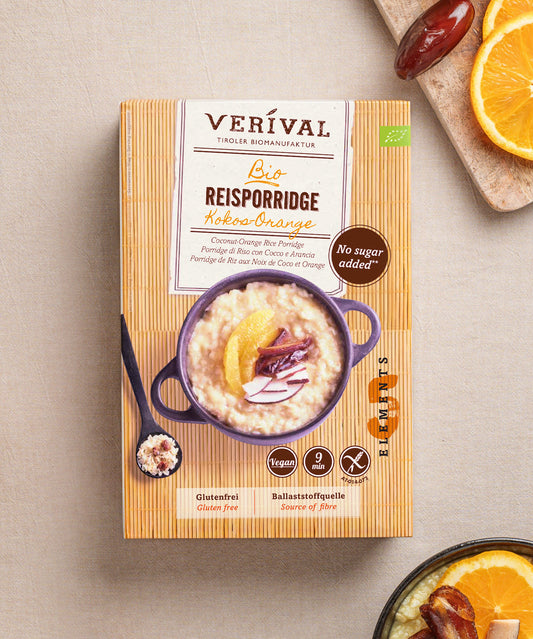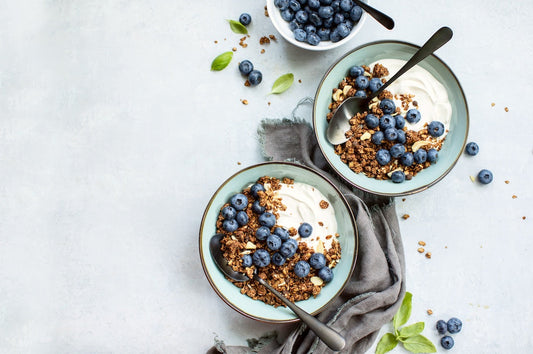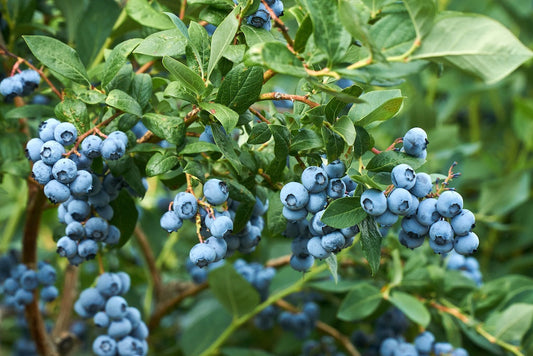Have you heard of oat bran? Have you tried it? Or maybe you even add it to your muesli regularly? But are you aware of the dietary fiber content of oat bran? Here you will learn everything you need to know.
What is oat bran?
Oat bran is a true superfood that is obtained from the outer layers of the oat grain. It is characterized by its exceptionally high content of soluble fiber, especially beta-glucan.
Oat bran, oats and co- what's the difference?
Everything you need to know about oat bran
Dietary fiber and its importance for health
These dietary fibers have been shown to have positive effects on your cholesterol and blood sugar levels. Oat bran thus makes an important contribution to promoting your cardiovascular health. In addition, it has a positive effect on your intestinal flora, prevents constipation and ensures an increased stool volume. With its impressive content of micronutrients such as vitamin B1, manganese and folic acid, oat bran enriches your diet and contributes to your overall health.
What exactly is fiber?
Fiber is an important component of your diet found in plant-based foods. Fiber is a carbohydrate that cannot be completely broken down by the human digestive system. Essentially, it is the indigestible parts of plants that pass through your gastrointestinal tract without being digested.
2 types of dietary fiber
Dietary fiber can be roughly divided into two main categories: soluble and insoluble fiber. This categorization is based on their solubility in water and their respective properties in the digestive system.
Soluble fiber
This type of fiber dissolves in water to form a gel-like substance. They are found in foods such as oats, legumes, apples and citrus fruits. Soluble fibers have a special ability to bind water and various substances in the digestive tract. This means that they can regulate blood sugar levels by slowing down the absorption of glucose.
In addition, they can help lower blood cholesterol levels by binding bile acids and promoting their excretion. Due to their gel-like consistency, they can also create a feeling of satiety and thus be helpful in weight control. Soluble dietary fibers are therefore (at least partially) digestible. They are largely broken down by intestinal bacteria and thus serve as “food” for positive intestinal bacteria.
Insoluble fiber
In contrast, insoluble fiber does not dissolve in water and largely retains its structure in the digestive tract. It is found in foods such as whole grains, vegetables and fruit peel.
Insoluble fiber has the ability to bind water and increase stool volume. This promotes the movement of intestinal contents and makes it easier to prevent constipation. They are important for overall intestinal health and support regular bowel movements. Insoluble fiber is completely indigestible.
Incorporating both soluble and insoluble fiber into your diet is crucial to reaping the many health benefits of these important nutrients. While soluble fiber helps regulate your blood sugar levels and cholesterol levels, insoluble fiber supports your digestive function and gut health. Thus, a balanced diet that includes both types of fiber is key to a healthy lifestyle.
Fibre content of oat bran compared to other foods
Although dietary fiber is considered a nutrient-poor component of our food and passes through our body largely unprocessed, it is essential for the well-being of our organism. In particular, they are important for a healthy digestive system, as they not only promote the growth of beneficial intestinal flora, but also counteract constipation and stimulate digestive activity. A diet rich in fiber also helps to reduce the risk of colon cancer.
| Foods | Grams of fiber/ 100 grams |
| Jerusalem artichoke | 12.5 |
| Artichoke | 11 |
| Passion fruit | 10 |
| Avocado | 7 |
| Elderberries | 7 |
| Raspberries | 7 |
| Bananas | 10 |
| Figs | 10 |
| Apples | 9 |
| Dates | 8 |
| Millet | 9 |
| Quinoa | 7 |
| Oat bran | 15 |
Explanation of special dietary fiber in oat bran – all about beta-glucan
Beta-glucan is a group of soluble dietary fibers found mainly in the cell walls of grains, but also in yeasts, mushrooms and algae. These polysaccharides consist of glucose molecules connected by β-glycosidic bonds. Due to this unique chemical structure, they have remarkable properties that have a positive effect on many areas of your health.
The way beta-glucan works is complex and has gained particular importance in modern nutritional science:
Blood sugar regulation: After eating, beta-glucan slows down the absorption of glucose in your gut, leading to steadier blood sugar levels and an improved insulin response.
Cholesterol management: The dietary fiber beta-glucan binds cholesterol in the intestines, which reduces the absorption of cholesterol into your bloodstream and thus lowers your cholesterol level. In particular, the reduction of LDL cholesterol (the “bad” cholesterol) is of interest here.
Digestive health: As a soluble fiber, beta-glucan can promote the growth of beneficial intestinal bacteria, increase your stool volume, and stimulate your intestinal peristalsis, which helps to prevent constipation.
Immunomodulation: beta-glucan is also said to have a strengthening effect on the immune system. It activates immune cells such as macrophages and neutrophils, which supports your body's defenses.
Regular intake of foods containing beta-glucan, such as oat bran or flakes, is often recommended to take advantage of these health benefits. Due to its ability to swell in water, beta-glucan is.
Practical tips: How to incorporate oat fiber into your daily routine
Ideas for breakfast, snacks, and side dishes with oat bran.
To get the day off to a healthy start, it's a good idea to incorporate oat bran into your morning meal. For example, you can add 30–40 grams of oat bran to a smoothie or soak it overnight in yoghurt, water or milk (alternative) – similar to overnight oats. Soaking also makes the tightly bound minerals and trace elements (iron, magnesium, zinc, selenium) even more absorbable. You can add oat bran to any muesli you prepare.
Two tablespoons of oat bran as a topping on fruit salad or muesli also increase the feeling of satiety and prevent hunger pangs. Oat bran can be used in a variety of baked goods. It can also be stirred into shakes, pancakes and sauces.
You can also add the superfood to savory dishes, such as stir-fried vegetables, goulash, or soup.
Tips for proper preparation and dosage
When using oat bran, it is important to always ensure that you drink enough fluids. This will ensure that you do not experience any unpleasant side effects (such as bloating and constipation). 30–40 g of oat bran (which is about 2–3 large tablespoons ) per day is perfectly adequate – observe your body to see how much oat bran it prefers and can process well.
What does Verival have to offer in terms of fiber?
There are endless possibilities for laying the foundation for a healthy diet first thing in the morning – and we at Verival are happy to help! With our filter function in the online shop, you can easily discover the breakfast products that are highest in fiber. To do this, click on “Filter” on the breakfast overview and then select either “Fiber source > 3g/100g” or “High fiber content > 6g/100g”. This way you can quickly and easily find the basis for your high-fiber breakfast.
One example of a high-fiber porridge from our range is Protein Sport Porridge Raspberry-Cocoa. Your daily power breakfast: 100g of Sport Porridge provides you with 25% of your required proteins, all essential amino acids, 23% of the daily requirement of important vitamins and minerals, as well as your entire daily requirement of valuable beta-glucans. And all this is purely plant-based and without added sugar.
Another product that contains almost 80% oat bran is the sour cherry cocoa oat porridge. As with all our products, it is quick and easy to prepare.
Put 50 g of porridge (6 tablespoons) in a bowl and pour over about 130 ml (depending on how thick you like it) of boiling water or 90 ml of hot milk (dairy-free milk alternative), then stir and leave for 3 minutes. It's best to enjoy your porridge while it's still warm. “Overnight oats”: add a little more cold water or cold milk and leave to stand overnight.
If you want to get lots of fiber from oat bran, the apricot-honey porridge is also a perfect choice. This fiber bomb contains the following ingredients: oat bran* 76.4%, chopped apricots* 9% (apricots* 97%, rice flour*), apricot granules* 7.8% (fruit* (apricot puree* 26.5%, apple puree concentrate*), raw cane sugar*, fructose syrup*, rice flour*, concentrated lemon juice concentrate*, cocoa butter*, gelling agent: pectin, natural flavoring: apricot), honey granules* 6.8% (raw cane sugar*, glucose syrup*, apple puree concentrate*, rice flour*, honey* 5%, oat fiber*, cocoa butter*, gelling agent: pectin).
Verival offers you many more options for getting fiber in a tasty and easy way.
High-fiber breakfast from Verival
Oat bran vs. oat flakes
Oat bran and oat flakes are both healthy foods that are obtained from the oat grain and are ideal for incorporating into a balanced diet.
While oat flakes are made from the whole kernels (including the whole endosperm) by steaming and flattening them, oat bran consists of the outer layers of the grain, the so-called outer layers, as well as the seedling. This means that oat bran has a higher proportion of fiber, especially soluble fiber such as beta-glucan.
With its higher concentration of dietary fiber, oat bran can contribute to improved intestinal flora, prevent constipation and increase stool volume when taken in equal amounts. Compared to oat flakes, it can therefore be considered the more concentrated “superfood”. Both forms can be used in a variety of ways, whether in smoothies, porridge, muesli or as an ingredient in a variety of recipes (such as cauliflower-oat patties, bread, oatmeal-oat bran cutlets, muffins, biscuits, etc.) that enrich the diet and at the same time support a healthy nutrition.
The local superfood oat bran – a conclusion
In summary, it can be said that oat bran is a high-quality source of fiber, especially of beta-glucan. These valuable ingredients contribute to maintaining your health in a variety of ways – they support your digestion, regulate your blood sugar and cholesterol levels, and can specifically strengthen your immune system.
It is recommended to gradually increase your intake of oat bran to help your body get used to the positive effects of fiber and to get the most out of the health benefits. For example, start by adding oat bran to your daily smoothie or use it as a topping on your breakfast. This way, you can make your diet not only healthier, but also more varied and enjoyable.
By the way: oat bran is also good for low-carb diets.
Nutritional values of oat bran
As for this aspect, there is a separate article that specifically addresses the nutritional values of oat bran.
Frequently asked questions
Is oat bran high in fiber?
Yes, oat bran is extremely high in fiber and is considered one of the best sources of fiber in our diet. The exceptional fiber density of oat bran is mainly due to the presence of beta-glucan, a soluble fiber concentrated in the outer layers of the oat kernel. This fiber is responsible for the beneficial health effects of oat bran, including lowering cholesterol and regulating blood sugar levels.
Which is better, oatmeal or oat bran?
Both oat products have their merits, but oat bran is the leader in terms of fiber content. If your main goal is to increase your fiber intake, oat bran is the better choice. Of course, oatmeal is just as healthy and should definitely be used in a balanced diet to get the most out of its specific benefits.
How much oat bran should you eat a day?
The recommended amount of oat bran can vary, but a general guideline is to consume about 30 to 40 grams of oat bran daily. This amount is considered sufficient to reap the health benefits of oat bran, particularly in terms of lowering cholesterol and regulating blood sugar levels. However, it is important not to overdo it, as too much fiber can cause digestive discomfort such as constipation.
What does oat bran do in the gut?
Oat bran has several positive effects in the gut. The soluble fibers, especially beta-glucan, form a gel-like substance in the digestive tract. This slows down digestion and the absorption of nutrients, which helps to maintain stable blood sugar control. In addition, oat bran has a positive influence on the intestinal flora because it acts as a prebiotic. This promotes a healthy intestinal environment and ensures well-functioning digestion.
Is oat bran a dietary fiber?
Yes, oat bran is very high in dietary fiber, especially soluble fiber such as beta-glucan. These dietary fibers are responsible for many of the health benefits of oat bran, including lowering cholesterol and regulating blood sugar levels. They also have a positive effect on digestion and gut health.
Is oat bran good for your gut?
Yes, oat bran is good for your gut. The fiber in oat bran, especially a substance called beta-glucan, positively influences gut health by supporting the formation of healthy gut flora. It can also improve digestive function and help prevent constipation. The soluble fiber in oat bran forms a gel-like substance in the digestive tract that aids in bowel movement.
Which bran has the most fiber (oat bran, wheat bran, etc.)?
Oat bran is characterized by its particularly high fiber content. Other types of bran, such as wheat bran and rice bran, also contain fiber, but oat bran has particularly impressive health benefits due to its high beta-glucan content.

